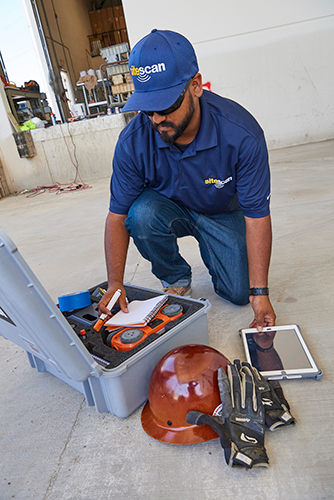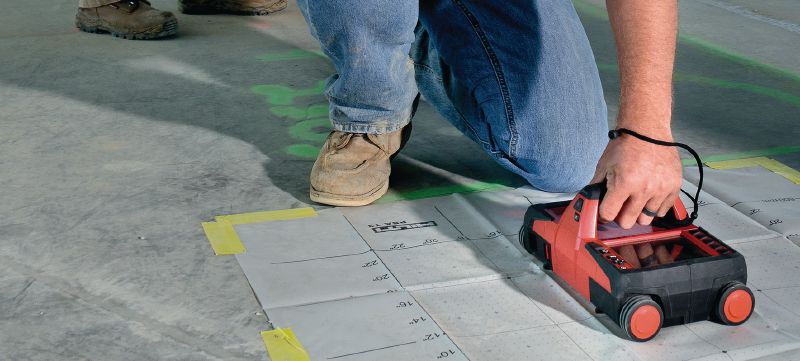Advanced Concrete Scanning Techniques: Guaranteeing Architectural Stability
Advanced Concrete Scanning Techniques: Guaranteeing Architectural Stability
Blog Article
Introduce the Transformative Power of Concrete Scanning in Taking Full Advantage Of Performance and Security
Concrete scanning has actually emerged as a vital tool in the construction market, using unmatched benefits in improving job effectiveness and making certain safety and security standards. The transformative power of concrete scanning exists in its capability to supply real-time information and thorough understandings, revolutionizing how tasks are prepared and carried out.
Value of Concrete Scanning
Ensuring the architectural integrity and security of construction tasks begins with the essential action of conducting comprehensive concrete scanning. Concrete scanning is a non-destructive method utilized to detect and map subsurface aspects within concrete frameworks.
Additionally, concrete scanning helps in optimizing project timelines and budget by avoiding unforeseen expenses and hold-ups that might develop due to unpredicted blockages within the concrete. Ultimately, spending in comprehensive concrete scanning is a positive method that improves both performance and safety and security in building and construction jobs.
Exactly How Concrete Scanning Works
Concrete scanning operates as a vital tool in building jobs by utilizing innovative innovations to spot and map subsurface elements without causing architectural damage. Ground Passing Through Radar (GPR) and Electromagnetic Induction (EMI) are two key techniques utilized in concrete scanning.
During the scanning procedure, the information collected is evaluated in real-time, permitting prompt identification of prospective threats or barriers beneath the surface. By employing these sophisticated modern technologies, concrete scanning considerably minimizes the danger of expensive problems and injuries on construction sites.
Benefits of Concrete Scanning
One of the primary benefits of concrete scanning is the ability to discover and locate ingrained objects such as rebar, post-tension cable televisions, and conduits accurately. Concrete scanning aids in planning and making a lot more properly, as it gives accurate details about the place and deepness of structural components.

Situation Research Studies: Concrete Scanning Success

In another situation, a building and construction company utilized 3D concrete scanning to assess the find more information problem old concrete frameworks in a historic building. The in-depth scans supplied beneficial understandings right into the degree of wear and tear and assisted prioritize maintenance initiatives efficiently. By proactively attending to locations of worry identified through scanning, the business was able to expand the life expectancy of the structure and ensure owner safety.
These study highlight the transformative power of concrete scanning in enhancing effectiveness, precision, and safety and security in construction jobs.
Implementing Concrete Scanning in Projects
Carrying out advanced scanning modern technologies throughout building jobs has ended up being increasingly crucial for enhancing precision and safety. By integrating concrete scanning right into project preparation and implementation, building and construction teams can determine prospective dangers, such as rebar or post-tension cords, concealed within concrete structures. This aggressive method lessens the danger of crashes, delays, and expensive rework, eventually causing more reliable job timelines and budget plans.
To execute concrete scanning effectively, task managers should team up carefully with knowledgeable scanning experts to identify one of the most ideal scanning strategies for the details job demands. Engaging scanning professionals from the very early phases of a task allows the team to produce detailed scanning plans that resolve key locations of concern and guarantee comprehensive data collection.
Moreover, including concrete scanning right explanation into routine project operations can improve decision-making procedures, as real-time scan data supplies prompt understandings into the condition of concrete structures - Concrete Scanning. This data-driven strategy helps with informed analytic and allows teams to make adjustments promptly, fostering a society of performance and safety throughout the project lifecycle

Final Thought
In verdict, concrete scanning plays a crucial function in improving effectiveness and safety and security in building and construction projects. By utilizing advanced technology to identify and map out underlying structures within concrete, this procedure helps to avoid costly errors, ensure structural stability, and lessen threats on website. With the ability to uncover covert aspects and supply exact information, concrete scanning proves to be a beneficial device for maximizing task outcomes and maximizing overall success.
Concrete scanning is a non-destructive technique utilized to identify and map subsurface components within concrete frameworks. In addition, concrete scanning aids in maximizing task timelines and budget by avoiding unexpected costs and delays that may arise due to unanticipated blockages within the concrete. One remarkable case study entails a large improvement project where concrete scanning played a critical duty in making certain job success.In one more situation, a building company made use of 3D concrete scanning to examine the problem of maturing concrete structures in a historical structure. By incorporating concrete scanning into project preparation and implementation, building groups can recognize prospective hazards, such as rebar or post-tension cables, concealed within concrete structures.
Report this page